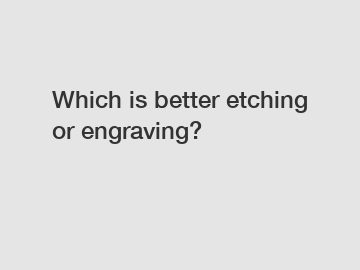Which is better etching or engraving?
H2: Understanding the Difference Between Etching and Engraving.
When it comes to deciding whether etching or engraving is better, it's important to understand the differences between the two processes. Etching involves using an acid or a corrosive substance to create a design on a surface, while engraving involves cutting or carving a design into a surface using a sharp tool. Both processes have their own set of advantages and disadvantages, so it's important to consider your specific needs and preferences before making a decision.
H3: Advantages of Etching.

One of the main advantages of etching is that it allows for a high level of detail and precision in the design. Etching is also a relatively quick and cost-effective process, making it ideal for large-scale projects. Additionally, etching can be used on a variety of materials, including metal, glass, and acrylic. Another advantage of etching is that it results in a smooth and even finish, making it ideal for creating intricate patterns and designs.
H3: Disadvantages of Etching.
One of the main disadvantages of etching is that it can be difficult to control the depth of the design, which can result in uneven or inconsistent results. Additionally, etching may not be suitable for all materials, and the use of corrosive substances can be harmful to the environment. Etched designs may also be prone to fading over time, especially if they are exposed to harsh conditions or sunlight.
See also:Unlock the Secret to Stainless Steel Table Leg Parts
Perforated Metal Panels for Space Partition Wall Design
How to Maintain Conveyor Table Top Chains
High Pressure Valves
5 Must-Have Features in a Connect Bridge
5 Reasons Why Every Entrepreneur Should Build a Prototype
Motor Housing vendor
H3: Advantages of Engraving.
Engraving offers a more traditional and permanent solution for creating designs on a surface. The depth and clarity of the design can be easily controlled with engraving, resulting in crisp and detailed results. Engraving is also a versatile process that can be used on a wide range of materials, including metal, wood, and plastic. Additionally, engraved designs are durable and long-lasting, making them ideal for items that will be subjected to wear and tear.
H3: Disadvantages of Engraving.
One of the main disadvantages of engraving is that it can be a time-consuming and expensive process, especially for intricate designs. Engraving also requires a higher level of skill and precision than etching, which can make it difficult for beginners to achieve professional results. Additionally, engraved designs may not be as smooth and uniform as etched designs, especially on softer materials.
In conclusion, whether etching or engraving is better depends on your specific needs and preferences. Etching is a quick and cost-effective option that offers high levels of detail, while engraving provides a more traditional and permanent solution with crisp and durable results. Consider the advantages and disadvantages of each process before making a decision.
For more information, please visit stamped stainless steel sheet manufacturer, polished stainless plate, china super mirror polishing suppliers.
See also:When to Use Stainless Steel Casting?
10 Things to Consider When Buying Plastic Conveyor Chain
Maximize Efficiency: Yamaha SMT Feeder Tips & Troubleshooting
5 Must-Have Features in a precision cnc machining part
Smt Feeder Parts: Original vs. Aftermarket – Which is Better?
How to Save Money When Buying flange washers
Top Samsung Cp Feeders Innovations to Watch in 2025
- Previous: Unlock the Secret to Stainless Steel Table Leg Parts
- Next: None



